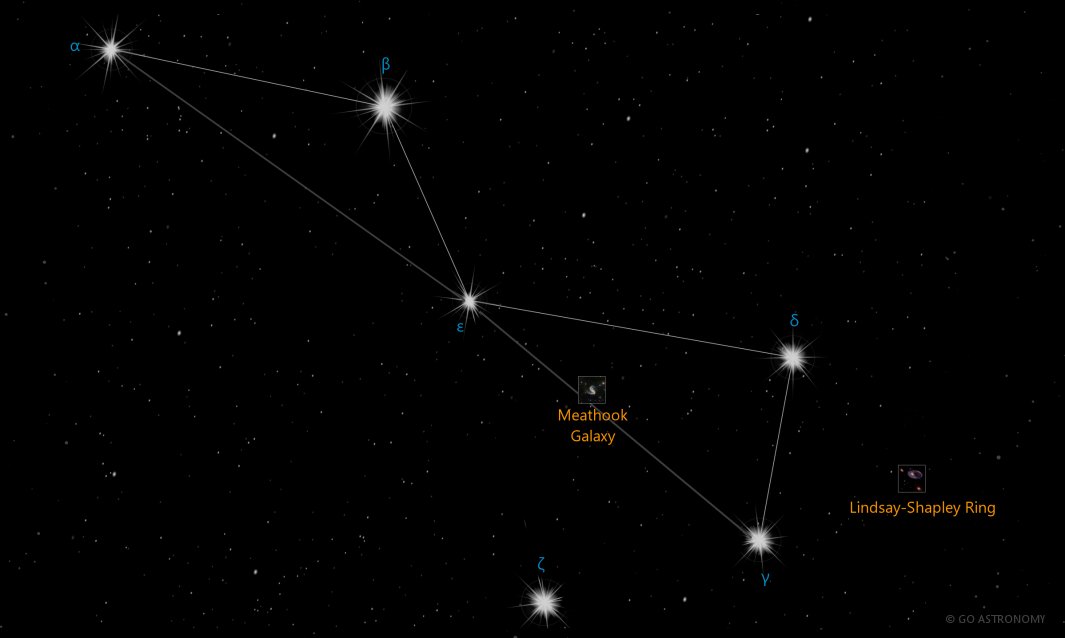Volans, the Flying Fish (Vol)
(VOH-lanz)
The Southern constellation of Volans, the Flying Fish, is best viewed in Spring during the month of March.
Volans is the 76th largest constellation. It's brightest star is Beta Volantis at magnitude 3.77. The boundary of the Volans constellation contains 3 stars that host known exoplanets.
Volans is a circumpolar constellation, so is visible year-round in the Southern hemisphere. Conversely, it is not visible in the opposite hemisphere.
- Pronunciation:
- VOH-lanz
- Meaning:
- Flying Fish
- Genitive:
- Volantis
- Abbreviation:
- Vol
- Constellation Family:
- Bayer
- Hemisphere:
- Southern
- Quadrant:
- SQ2
- Visibility:
- 15° N - 90° S
- Best viewing month*:
- March
- Area:
- 141 sq. degrees
- Size:
- 76th largest
- Circumpolar** (N=northern, S=southern):
- S circumpolar
- Right Ascension (avg):
- 7h 40m
- Declination (avg):
- -69°
- Brightest star:
- Beta Volantis (3.77)
- Stars with planets:
- 3
- X-ray stars:
- 1 stars
- Messier objects:
- |
- Caldwell objects:
- |
Brightest Stars in Volans
The 10 brightest stars in the constellation Volans by magnitude.
- Star
- Magnitude
- Spectral class
- Gamma Volantis (γ2 Vol)
- 3.62
- G8IIIvar
- Beta Volantis (β Vol)
- 3.77
- K2IIIvar
- Zeta Volantis (ζ Vol)
- 3.93
- K0III
- Delta Volantis (δ Vol)
- 3.97
- F6II
- Alpha Volantis (α Vol)
- 4
- Am
- Epsilon Volantis (ε Vol)
- 4.35
- B6IV
- HD 70514
- 5.06
- K1III
- HD 53501
- 5.18
- K3III
- Theta Volantis (θ Vol)
- 5.19
- A0V
- Eta Volantis (η Vol)
- 5.28
- A0/A1IV/V
Galaxies in Volans
The most notable galaxies in the constellation Volans. Also see all galaxies.
- Name
- Alt name
- Type
- Lindsay-Shapely Ring
- ring
- Meathook Galaxy
- spiral
- NGC 2305
- elliptical
- NGC 2397
- spiral
- NGC 2434
- elliptical
- NGC 4033
- elliptical
- NGC 4050
- spiral
- NGC 4094
- spiral
- NGC 4462
- spiral
- NGC 4783
- elliptical
Soaring through the Southern Sky
The celestial chart is not just confined to the well-known zodiac constellations. Some fascinating celestial entities are quietly tucked away in the far reaches of the sky. One of these is Volans, a small and dim constellation nestled in the southern hemisphere.
Historical Overview
Volans, Latin for 'flying fish', is one of the 12 constellations introduced by the Dutch astronomer Petrus Plancius in the late 16th century. It was based on observations by Dutch navigators Pieter Dirkszoon Keyser and Frederick de Houtman during their voyages in the southern seas. Later, Volans was included in the 88 modern constellations defined by the International Astronomical Union (IAU).
Location and Main Characteristics
Located in the second quadrant of the southern hemisphere (SQ2), Volans is surrounded by the constellations Carina, Chamaeleon, Dorado, Mensa, and Pictor. Covering an area of about 141 square degrees, it is relatively small and faint, making it challenging to observe, especially from light-polluted areas. Nevertheless, it becomes visible around February and remains observable through April.
Significant Stars in Volans
Despite its faintness, Volans hosts a number of intriguing stars. The constellation's brightest star, Beta Volantis, is a spectral class G5III yellow giant approximately 107 light-years from Earth. With an apparent magnitude of 3.77, it's not particularly bright but still outshines the other stars in the constellation.
Gamma Volantis, the second brightest star, is a binary star system located approximately 142 light-years away. Its primary component is an aging giant star that has exhausted the hydrogen at its core.
Delta Volantis is another interesting star in the constellation. It's a spectral class K1III orange giant, which, like Gamma Volantis, has exhausted its core hydrogen and expanded to giant status.
Deep-Sky Objects in Volans
Due to its location away from the plane of our galaxy, the Milky Way, Volans doesn't contain many bright deep-sky objects. However, it does host a few galaxies that are observable with a decent amateur telescope. The Lindsay-Shapley Ring (AM 0644-741) is one of the most notable of these objects. It's a ring galaxy located some 300 million light-years away and was formed by a collision with another galaxy roughly 200 million years ago.
Observation
Given its southern location and faintness, Volans is not easy to spot, especially for observers in the Northern Hemisphere. For those living in the Southern Hemisphere, the best time to see Volans is during late summer and autumn months.
The best way to locate Volans is to first find the more prominent constellation Carina, which hosts the extremely bright star Canopus. From there, one can "hop" to the nearby constellation Pictor, and then to Volans. As always, a clear, dark sky away from city lights will provide the best viewing conditions.
While Volans may not hold the same recognition as some of the more prominent constellations, its historical origins and the challenge it presents to observers make it a fascinating subject of study. So, the next time you gaze up at the night sky, spare a thought for the little flying fish gliding silently in the celestial sea.
* Constellation shown for northen hemisphere skies. For the southern hemisphere, constellations appear rotated 180 degrees (upside-down and left-right reversed) from what is shown. Remember that seasons are reversed too - summer in northern latitudes is winter in southern latitudes.
** Circumpolar constellations are visible year-round in the hemisphere listed (and not at all in the opposite hemisphere).





